Which Tcp/ip Utility Can Be Used to Display Tcp/ip Configuration Information?
The ipconfig (short for IP Configuration) is a basic, yet popular, Windows network command-line utility used to brandish the TCP/IP network configuration of a computer. If you are familiar with Linux, this tool is similiar to ifconfig. This tool is oftentimes used for troubleshooting network connectivity issues. With ipconfig, yous can place the types of network adapaters on your computer, the calculator's IP address, the IP addresses of the DNS (Domain Name System) servers being used, and much more.
These commands shown hither are tested on a comptuer with Windows 10 but about will work in other versions of Windows as well.
Table of Content
- Overview
- How to Launch Control Prompt
- Ipconfig Syntax
- Ipconfig Parameters
- Example Usage
- ipconfig - Retrieves Basic TCP/IP Network Data (IP, subnet mask, gateway)
- ipconfig /all - Retrieves All TCP/IP Network Information (MAC address, adapter description, DHCP details)
- ipconfig /release - Releases the IPv4 Address of All Network Adapters
- ipconfig /release6 - Releases the IPv6 Address of All Network Adapters
- ipconfig /release <adapter> - Releases the IP Address of a Specific Network Adapter
- ipconfig /renew - Go a New IPv4 Address for All Network Adapters
- ipconfig /renew6 - Get a New IPv6 Accost for All Network Adapters
- ipconfig /renew <adapter> - Become a New IPv4 Address for a Specific Network Adapter
- ipconfig /displaydns - View DNS Enshroud
- ipconfig /flushdns - Purge DNS Cache
- ipconfig /all | findstr /v 00-00-00 | findstr Physical - Display MAC Address of Only Concrete Connected Network Adapters
- Other Usages and Getting Help
- Tips
- Redirect Output to Text File
- Recommended Reading
- Summary
Overview
The ipconfig is a Windows command-line utility used often to troubleshooting calculator network issues. If you are a Linux user, this utility is similar to ifconfig. This is often used to determine the local IP address, subnet mask, the gateway address, and other network configuration of a computer. Additionally, this tool is used to refresh DHCP (Dynamic Host Configuration Protocol) and DNS (Domain Name Arrangement) settings
While nearly of the data provided by the ipconfig control-line utility can be found via a more than user-friendly graphical interface, sometimes that interface may non be available and command prompt is your only available choice. If you are a assistance desk-bound technician or a network professional person, it is recommended that yous empathise the command-line method of retrieving a estimator'south network configuration, and information technology some cases, performing network functions.
How to Open Command Prompt
To employ this utility, you will need to launch the Command Prompt window. The three mutual ways to launch the Control Prompt window are:
- Search for
cmdusing the congenital-in Windows search tool. - Correct-click on the Offset icon and select Control Prompt.
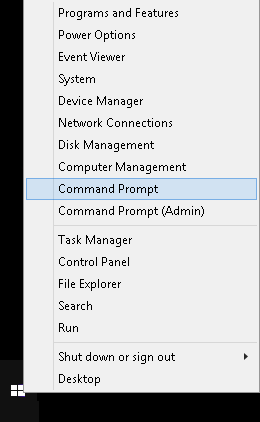
- Press the keyboard combination WinKey + R , then type
cmdat the Run window that appears.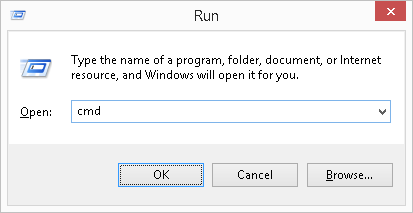
Ipconfig Syntax
ipconfig [/allcompartments] [/all] [/renew [<Adapter>]] [/release [<Adapter>]] [/renew6[<Adapter>]] [/release6 [<Adapter>]] [/flushdns] [/displaydns] [/registerdns] [/showclassid <Adapter>] [/setclassid <Adapter> [<ClassID>]]>
Ipconfig Parameters
| Parameter | Description |
|---|---|
| /all | Display the full TCP/IP configuration information for all network adapters. |
| /release | Release the IPv4 accost for the specified adapter. |
| /release6 | Release the IPv6 address for the specified adapter. |
| /renew | Renew the IPv4 address for the specified adapter. |
| /renew6 | Renew the IPv6 address for the specified adapter. |
| /flushdns | Purges the DNS Resolver cache. |
| /registerdns | Refreshes all DHCP leases and re-registers DNS names. |
| /displaydns | Brandish the contents of the DNS Resolver Cache. |
| /showclassid | Displays all the DHCP form IDs allowed for adapter. |
| /setclassid | Modifies the DHCP class ID. |
| /showclassid6 | Displays all the IPv6 DHCP class IDs allowed for adapter. |
| /setclassid6 | Modifies the IPv6 DHCP class ID. |
| /? | Displays aid information. |
Example Usage
There are a variety of switches (sub commands) available with the ipconfig utility that volition either brandish certain data or perform certain network functions. At the virtually basic, the ipconfig displays a computer's IP accost, subnet mask and the default gateway (which is typically the IP address of your router or network firewall).
ipconfig - Think Basic TCP/IP Network Information
To become basic network information from your computer, blazon the following in the command window so press Enter: ipconfig
The screenshot example below is the ipconfig output of a item computer. The output of your ipconfig result will differ depending on your network setup and the blazon of network adapters installed on your computer. In our screenshot case, information technology shows the following basic networking information virtually the computer from which ipconfig was ran.
- IPv4 accost: 192.168.0.98
- Network subnet mask: 255.255.255.0
- Default Gateway: 192.168.0.1
Delight annotation that unless your calculator is connected directly to the Internet (this is rare), the IP accost reported past ipconfig volition be your local network IP, non your public external IP accost.
While other network details can be retrieved by the ipconfig utility, for most network troubleshooting, this is what is typically needed.
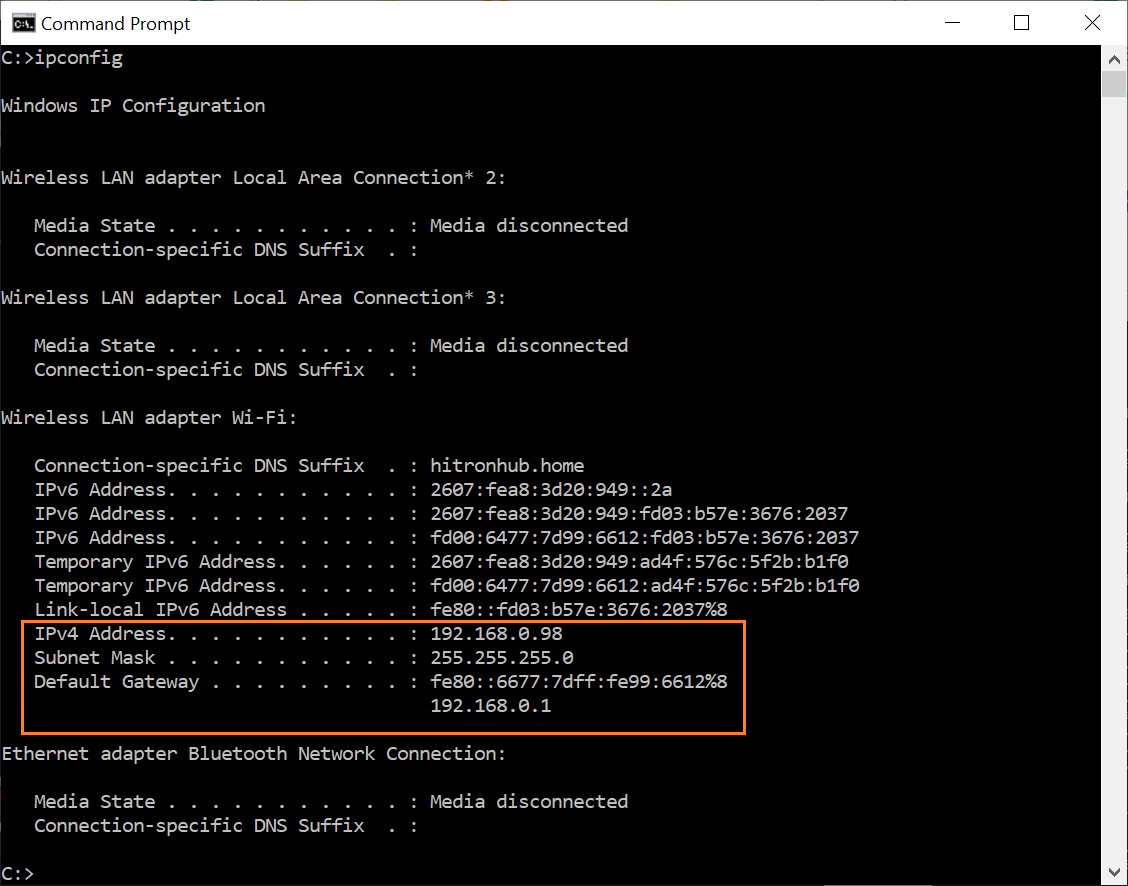
ipconfig /all - Recall All TCP/IP Network Information
Another useful switch with ipconfig is to have it study all TCP/IP network details for all network adapters on a computer. This is achieved past using the /all switch. This switch provides you lot with the same basic information as ipconfig described above, but with a lot more detail. To retrieve all network information most your computer, type the post-obit in the control window and then press Enter: ipconfig /all
This will show a detailed written report of various network details for the computer. Again, your written report will differ depending on your network setup and the network adapters installed on your computer. This study includes information such as:
- Make and model of your network adapter(southward)
- Physical address (likewise known equally the MAC address or hardware address) of your adapter(s)
- Whether your IP address is leased (i.e., DHCP issued or statically assigned)
- If IP address is leased, what the lease expiration and the DHCP that leased it
- DNS servers
Equally you can see, ipconfig /all provides you lot with a plethora of details about your computer network setup.
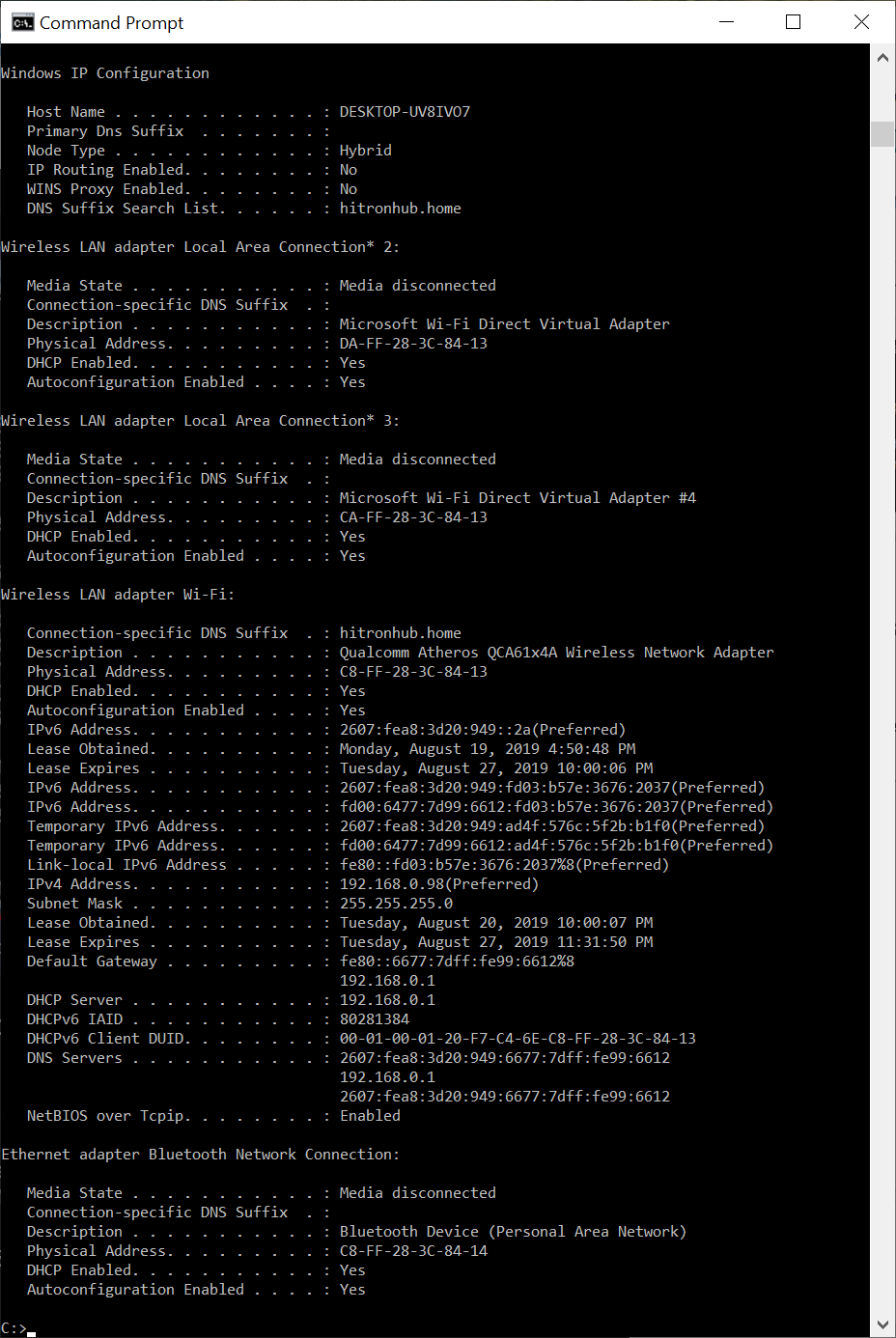
ipconfig /release - Releases the IPv4 Address of All Network Adapters
The /release switch will crusade ipconfig to become through the network adapters yous have and drop the dynamically issued IPv4 address by sending a DHCPRELEASE message to the DHCP server. For the bulk of the time, you lot would follow this command with ipconfig /renew (described below) will crusade your network adapters to reach out to your DHCP server for an IP address (it can be a new IP accost or the same IP you lot had prior to when you performed the /release control). For most, executing this command does not have adverse upshot on your computer.
To release your IP accost from your computer, type the following in the command window so press Enter: ipconfig /release
Note, if you have a statically assigned (manually assigned) IP accost, this command will not release it. Encounter instance ipconfig /renew for related information.
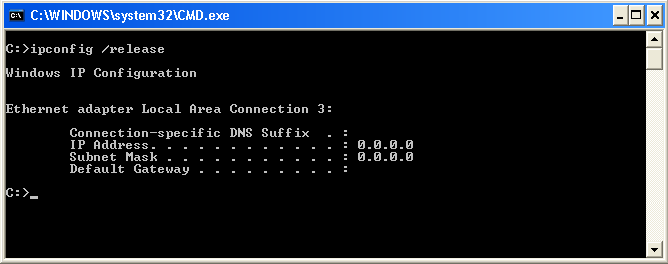
ipconfig /release6 - Releases the IPv6 Address of All Network Adapters
The command is like to ipconfig /release except it renews the IPv6 address on the adapters.
ipconfig /release <adapter> - Releases the IPv4 Address for a Specific Network Adapters
The /release <adapter> switch will cause ipconfig to driblet the dynamically issued IPv4 address by sending a DHCPRELEASE message to the DHCP server for a specific network adapter.
To release the IP address for a specific network adapter on your computer named "Local Area Connection iii", type the following in the command window then press Enter: ipconfig /release "Local Area Connection 3"
Notation, if you have a statically assigned (manually assigned) IP address, this command will not release it. See example for ipconfig /renew for related information.
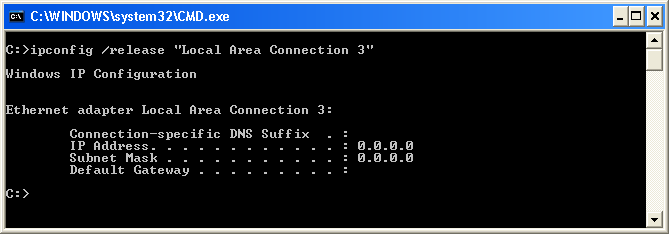
ipconfig /renew - Get a New IPv4 Accost for All Network Adapters
The ipconfig /renew will cause your estimator to reach out to your DHCP server for an IPv4 accost if it doesn't already have one or renews an existing one for all network adapters. Depending on how your DHCP server is configured or the pool of available addresses, the IP address you lot will receive can be one you had previously or it can be a new IP address. Once you execute this command, it volition typically have but seconds for a DHCP to assign your figurer with an IP address. In the analogy below, the IP accost assigned to this computer is 192.168.226.132.
To renew the IP address of your computer, type the following in the control window so press Enter: ipconfig /renew
See example for ipconfig /release for related information.
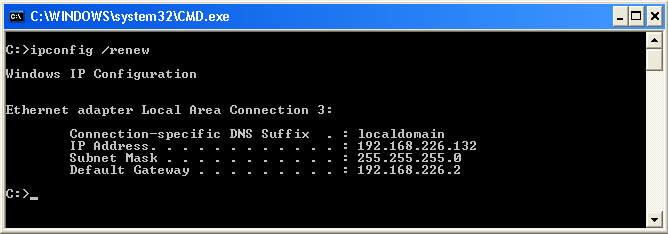
ipconfig /renew6 - Get a New IPv6 Accost for All Network Adapters
The control is like to ipconfig /renew except information technology renews the IPv6 address on the adapters.
ipconfig /renew <adapter> - Go a New IPv4 Address For a Specific Network Adapter
The ipconfig /renew <adapter> will cause your computer to achieve out to your DHCP server for an IPv4 address if it doesn't already have one or renews an existing one for a specific network adapter. Depending on how your DHCP server is configured or the pool of available addresses, the IP address you volition receive can be one you had previously or it can exist a new IP accost. One time you execute this command, it will typically take but seconds for a DHCP to assign your computer with an IP address. In the illustration below, the IP address assigned to the network adapter named "Local Expanse Connection 3" is 192.168.226.132.
To renew the IP address for a network adapter on your computer named "Local Expanse Connection 3", type the following in the command window so printing Enter: ipconfig /renew "Local Expanse Connection three". To notice out the name(s) of the network adapters on your reckoner, blazon the post-obit in the command window and then press Enter: ipconfig
Meet example for ipconfig /release for related information.
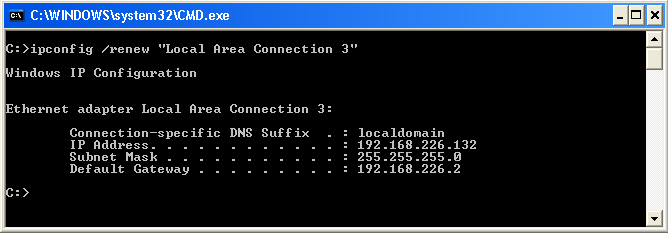
ipconfig /all | findstr /v 00-00-00 | findstr Physical - Display MAC Address of Only Physical Connected Network Adapters
The ipconfig utility, with the /all switch, is often used to detect the MAC address (the 6-byte 'burned-in' physical/hardware address) of network adapters. While this does the task, the output shows a plethora of information as mentioned higher up. If you have multiple adapters, the output tin be lengthy making information technology cumbersome to notice what you are looking for.
The Windows findstr utility is used to search for patterns of text. By feeding the output of ipconfig /all into findstr, we can significantly reduce the ataxia and have the output bear witness only the MAC address of concrete network adapters. To accomplish this, type the following in the control window and then press Enter:
ipconfig /all | findstr /v 00-00-00 | findstr Physical
This command is actually a series of three commands, namely:
-
ipconfig /all -
findstr /v 00-00-00 -
findstr Concrete
The vertical bar (|), more commonly referred to equally the pipe, is a 'command' that takes the output from the left side of the piping and feeds it as input to the command on the correct, bypassing the computer screen.
As the above command shows, the output of ipconfig /all is funneled into the command findstr /five 00-00-00 equally its input. The findstr with the /five switch will look for lines of text in the output of ipconfig /all that does not contain 00-00-00. What this does is exclude any network adapters that are disabled or not continued. These network adapters will take MAC address that starts with 00-00-00.
The result from the commencement findstr will withal comprise a lot of information that we can further filter out, such as DHCP lease information. To further reduce ataxia to ultimately end up with an output that lists just MAC address of physical adapters, we will need to funneled the output of the first findstr into a second findstr control. This second findster will filter out every line of text except those that has the discussion Physical.
This series of commands produce an output that is concise to show only the MAC accost of connected network adapters. Every bit the illustration beneath shows, this is a much more easier report to read as oppose to using merely using ipconfig /all.

ipconfig /displaydns - View DNS Cache
When y'all visit a website using it's domain name (east.chiliad., www.meridianoutpost.com), your estimator will need to know the IP accost for that website in society for information technology to discover information technology the server hosting information technology on the Internet. The process of identifying the IP address is chosen DNS lookup (analogous to looking upward a number in a telephone book). Once your estimator learns the associated IP address for the website you want to visit, it will enshroud it (store it) on your computer. The purpose of caching it is to improve operation by not having your figurer perform a DNS lookup each fourth dimension y'all access a web page on the website.
This control will listing all the currently cached IP addresses on your computer (likewise referred to as the DNS resolver cache). If you've accessed a lot of websites since turning on your computer, this listing can be very lengthy. The illustration below shows just a few entries out of many for a detail estimator. If you lot just turned on our computer and accept not access websites or servers on the network on the Internet, and so you list will just show a "localhost" setting in your local hosts file.
To brandish cached DNS entries on your computer, type the following in the control window and so press Enter: ipconfig /displaydns
This command is typically used to troubleshoot specific DNS lookup bug. Come across example for ipconfig /flushdns for related information.
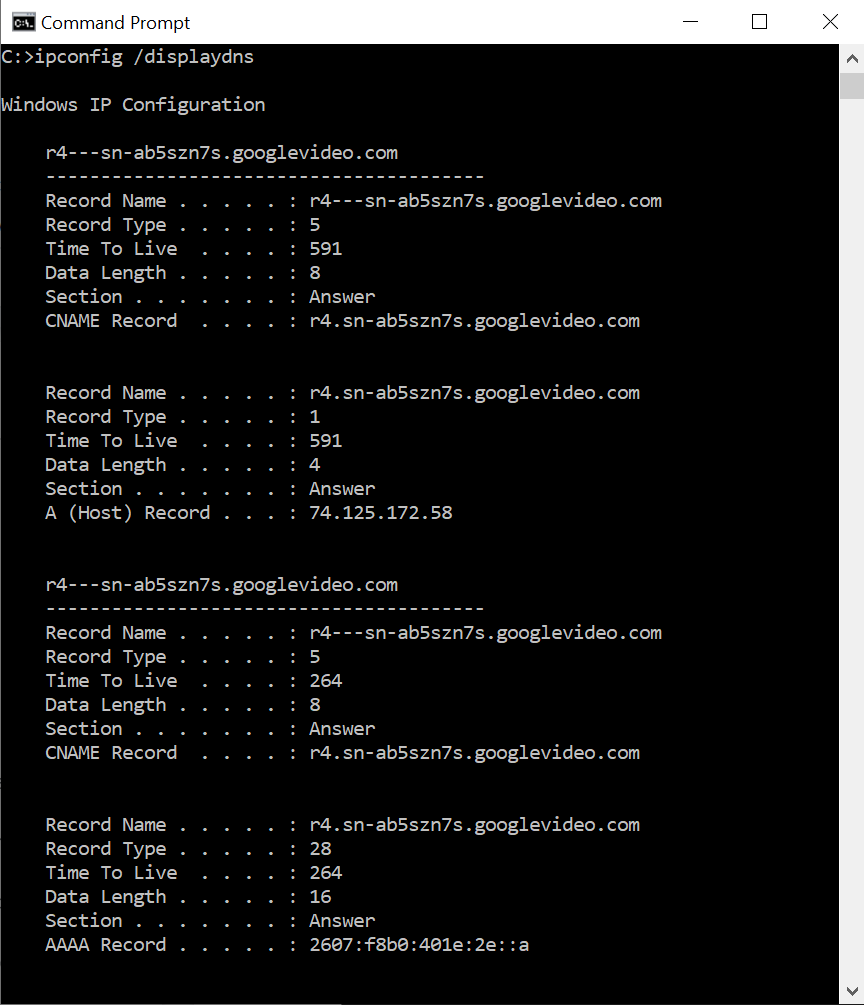
The information displayed on the list include:
- Tape Name: the name of the website or server that a DNS lookup was performed on
- Record Blazon:
- 1 = A
- two = NS (indicates the entry is a proper name server)
- 5 = CNAME (stands for canonical name and is a type of tape that maps an alias proper noun to a true domain name)
- xv = MX (indicates the entry is an electronic mail server)
- Time to Live: the time (in seconds) before this enshroud entry expires (can be every bit short as a few minutes to a few days)
- Data Length: the length (in bytes)
- eight Bytes = IPv4 address
- 16 Bytes = IPv6 address
ipconfig /flushdns - Purge DNS Cache
This command will purge the cached DNS entries on your estimator. You would typically do this to troubleshoot DNS related problems. An example of this is when you endeavour to admission a website just you encounter an error bulletin stating the website is not found. For most people, executing this command does not have agin event on your calculator. See example for ipconfig /displaydns for related information.
To delete all the cached DNS entries on your computer, blazon the post-obit in the command window and so press Enter: ipconfig /flushdns
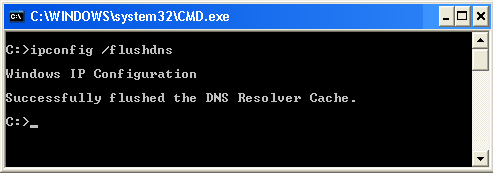
Other Usages and Getting Help
The instance usage described in the article shows simply some of the functions available with ipconfig. To get a list of the bachelor switches, type the post-obit in the control window and then press Enter: ipconfig /?
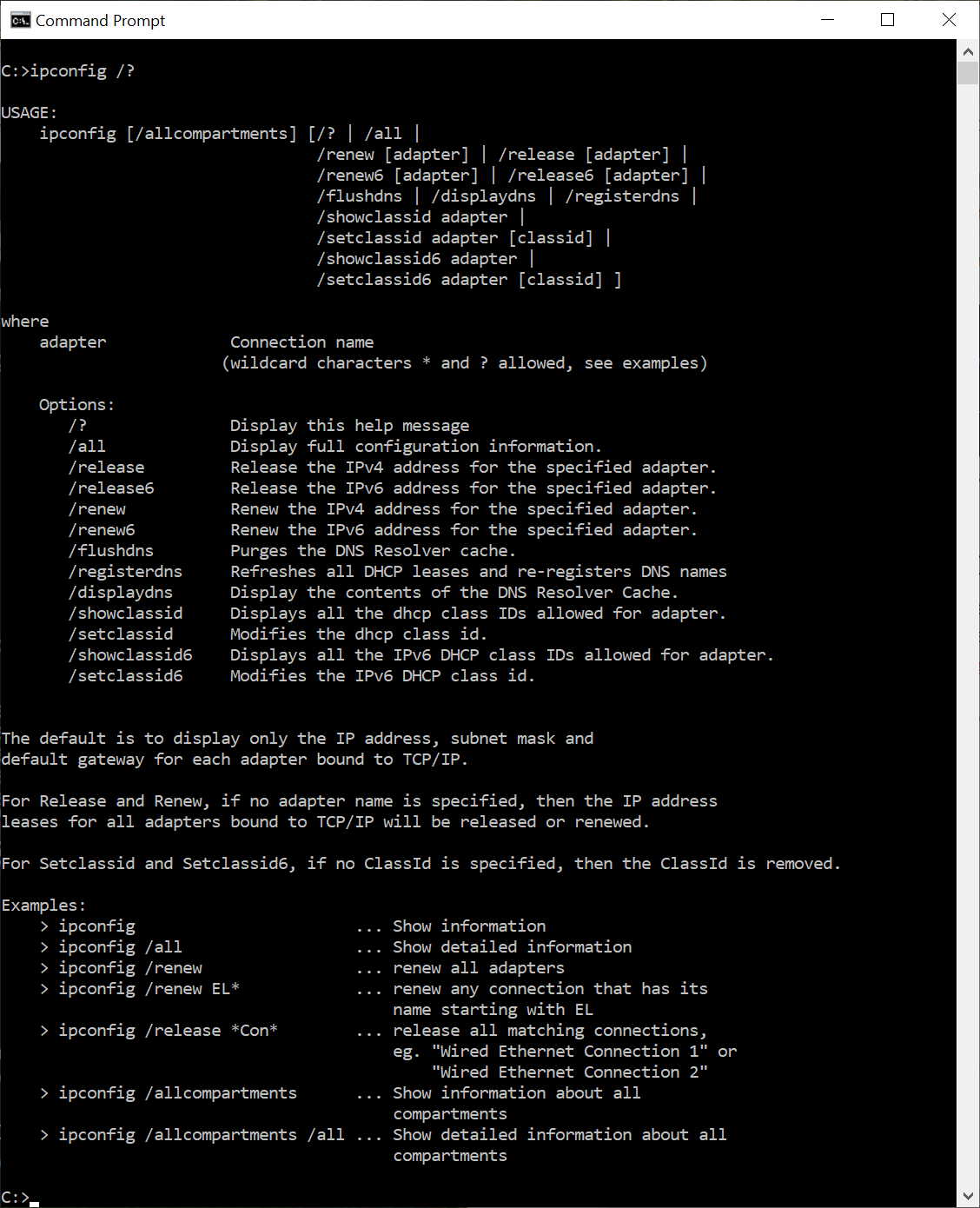
Tips
Redirect Output to Text File
- Instead of displaying the results on the screen, y'all can have the results saved automatically to a text file on your estimator. To exercise this, simply employ the ">" symbol followed past the folder path and file name of your choice. For example, to redirect the output of ipconfig /renew, type the following in the command window and then press Enter:
ipconfig /renew > c:\temp\ipconfig-results.txtThis will create a file named ipconfig-results.txt in the folder path c:\temp that will accept your upshot. Yous can and then open this file with any text editor, such as Notepad on a Windows computer, as illustrated beneath.
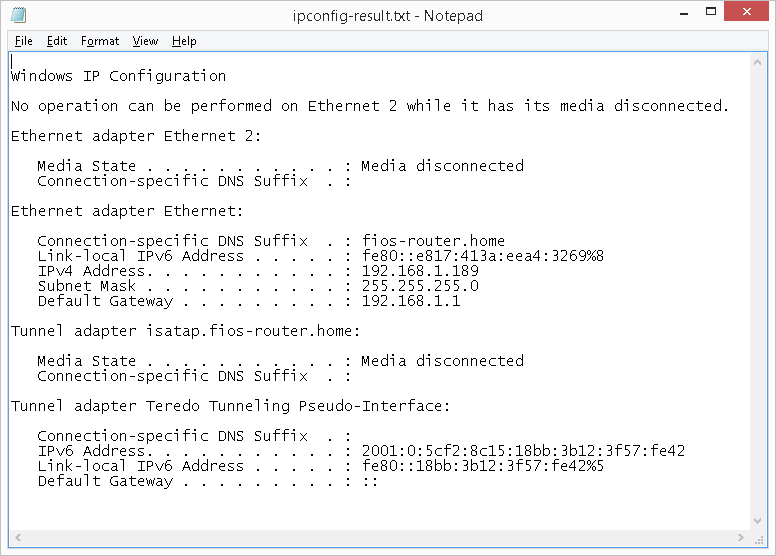
Recommended Reading
Improve confidence and job performance
Better productivity and efficiency
Learn more,
earn more
Life-long
investment
To learn more nearly this topic, we are providing you with recommendations to assist you farther your noesis. These are our chapter links to Amazon where you can purchase them and besides explore a multifariousness of other relevant books.
Summary
The ipconfig utility can provide a wealth of information for troubleshooting network issues. This utility is a valuable resource for computers that obtains an IP address automatically. If you are helpdesk technician, network administrator, or system administrator, this is a great utlity to become familiar with.
Source: https://www.meridianoutpost.com/resources/articles/command-line/ipconfig.php
0 Response to "Which Tcp/ip Utility Can Be Used to Display Tcp/ip Configuration Information?"
Postar um comentário